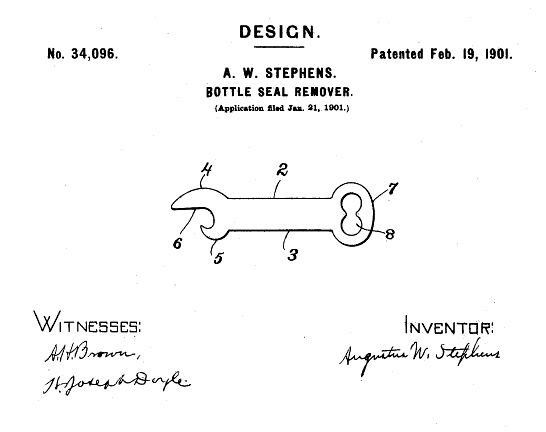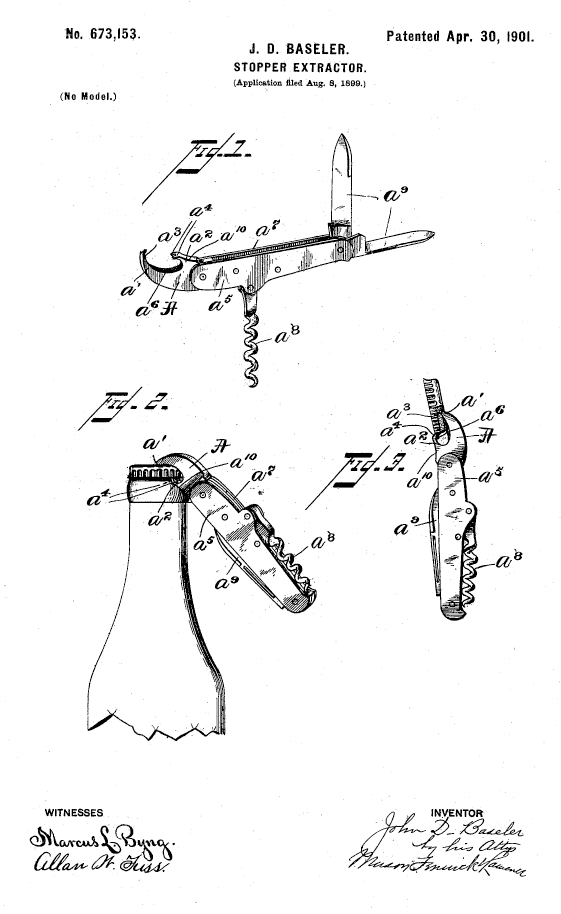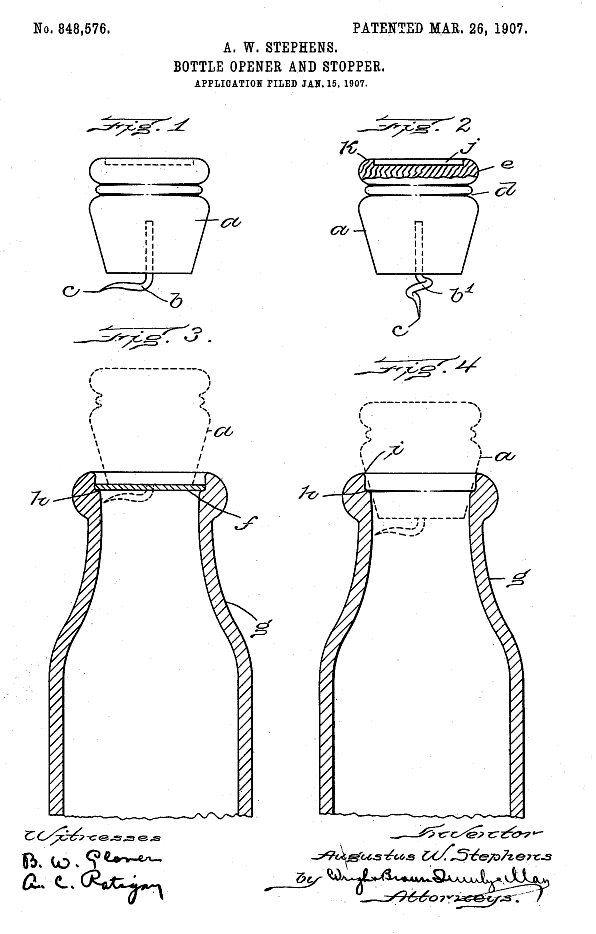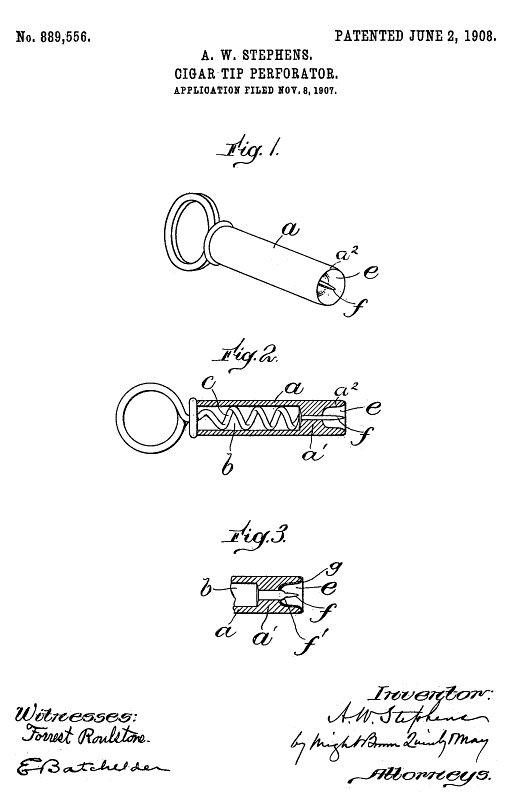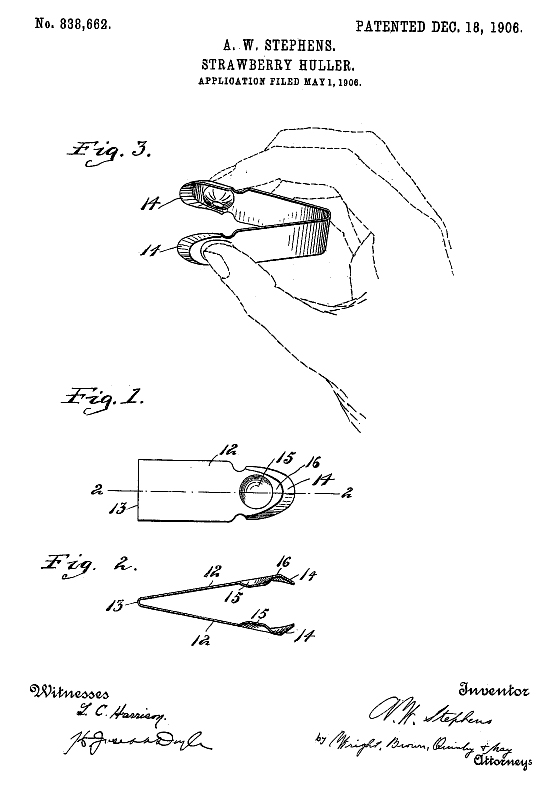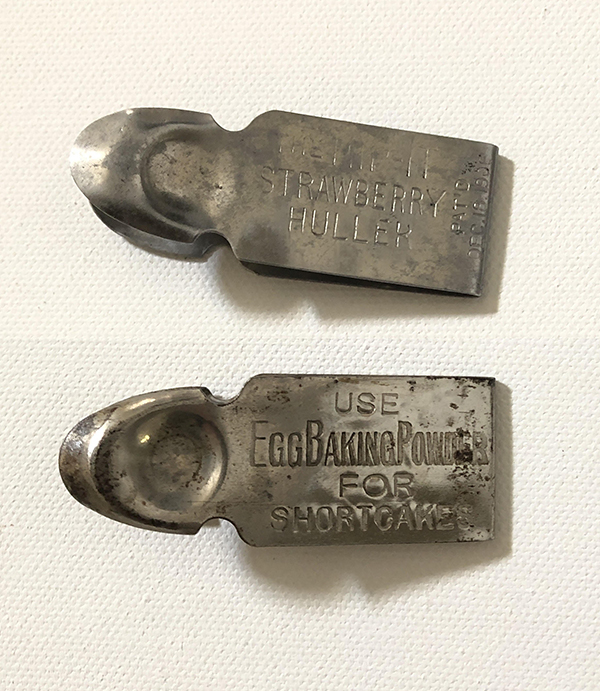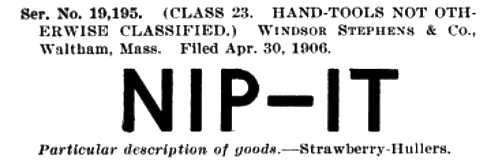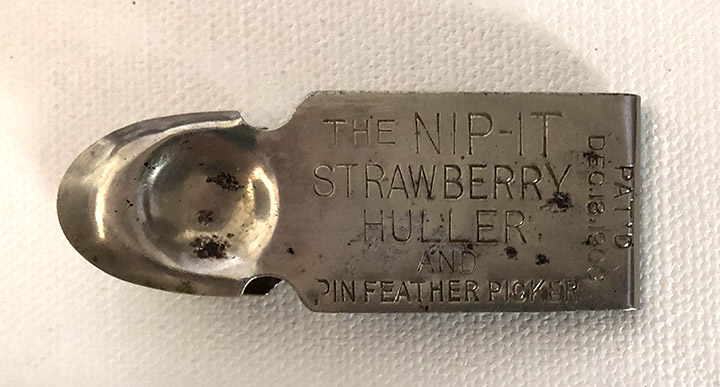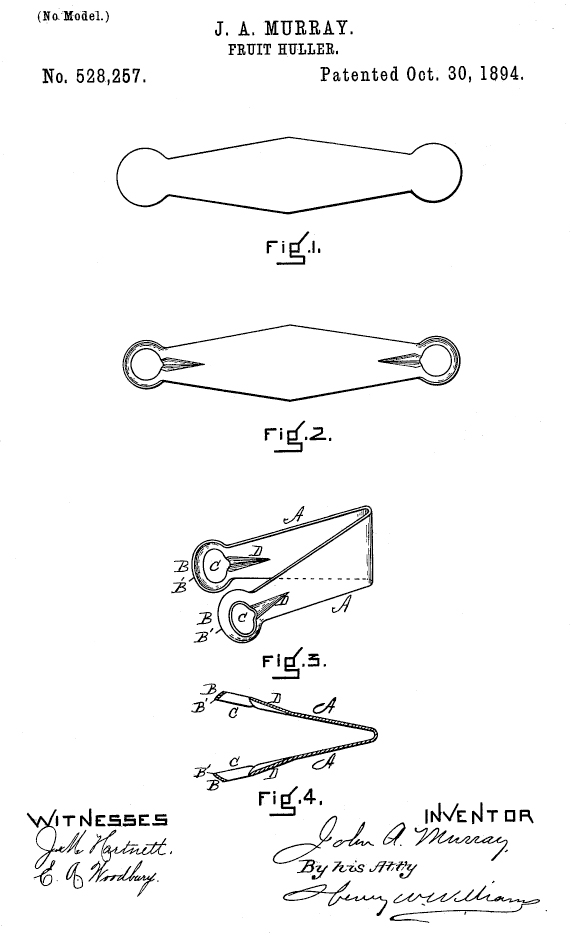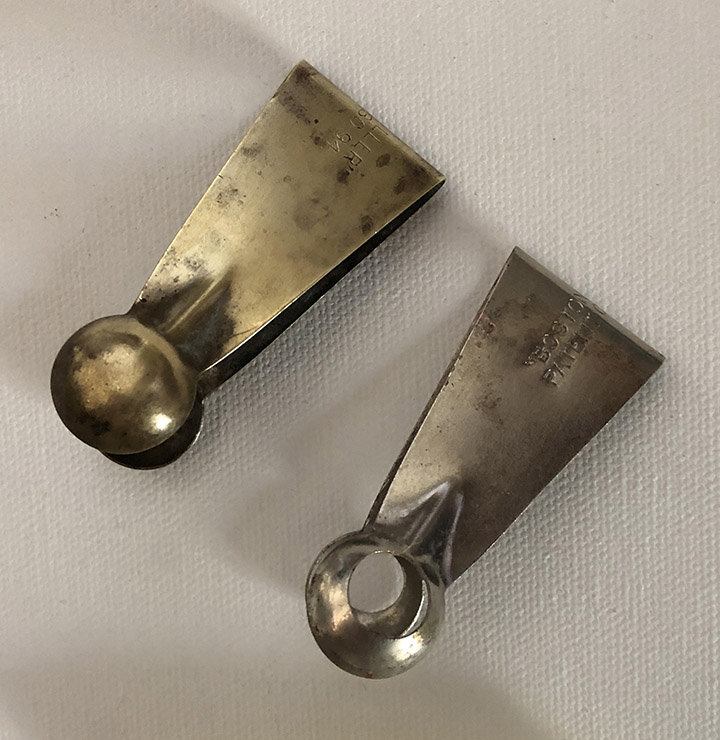IN THE EARLY 1900s, inventor Augustus W. Stephens made things a bit better for beer and soda drinkers, wine enthusiasts, milk drinkers, cigar smokers and strawberry eaters.
From 1901 through 1911 Stephens, of Waltham, Massachusetts, was awarded nine patents* that resulted in small products, most for advertising purposes. They were produced by his A.W. Stephens Manufacturing Company or his Windsor Stephens & Co.
Stephens’ February 19, 1901 Design Patent No. 34,096 for a bottle opener with a flat handle (“Place your ad here!”) was first produced by his Waltham factory. Over the years other stamping and manufacturing firms made the opener with advertising for dozens and dozens of breweries and soda companies.
Stephens also manufactured a combination bottle opener, corkscrew and knife based on a patent assigned to him by John D. Baseler. The April 30, 1901 Patent No. 673,153 for a “stopper extractor” had a flat side for advertising. One advertiser was DIPLOMAT WHISKEY ‘JUST RIGHT.’
Stephens’ 1901 bottle opener design patent also graced his company’s “ALL-WAYS Handy Combination Bottle Opener & Corkscrew.” That patent date and another one, by a different inventor, was cited in the literature in the original box the tool came in. Corkscrew pulls out from the wooden cylinder.
The second patent date was October 16, 1900, Patent No. 659,649, for a “machine for making corkscrews” and not a corkscrew. That patent was awarded to William Rockwell Clough of Alton, New Hampshire, a prolific and famous corkscrew and related items inventor. The explanation for citing that patent is that the machine made the corkscrew used in the “ALL-WAYS.”
Stephens March 26, 1907 Patent No. 848,576 was a “bottle opener and stopper” for milk drinkers whose milk at the time came mostly in bottles with paper tops.
Hardware Dealers’ Magazine magazine said in a 1908 article: “It is of wood in the form of a cork, made flaring, with a pointed wire inserted at the bottom of same. Taking out the paper caps on top of milk bottles frequently brings disastrous results to the person handling same. With this device the hook or prong easily enters the paper cap and it can be readily taken off. The device then acts as a stopper by being placed in the neck of the bottle.”
Stephens invited orders with a firm’s advertisement on the flat top of the stopper. “Advertisments embossed on opener and each one packed in a neat carton $20 per 1,000. Larger quantities, smaller prices,” Stephens said in an ad in a 1911 edition of Printers’ Ink.
Two years later, Stephens had refined the opener by adding a small handle and calling it “The Dainty Milk Bottle Opener.” An ad in 1913 in Milk Dealer magazine shouted: “MILK DEALERS – ATTENTION! We have the most economical and effective advertising ever offered for your trade.”
The ad said the new handle “is big enough for the attractive display of your advertisement – so neat so ‘petite’ that everybody instinctively names it the ‘Dainty’ – that’s the new advertising article you have been looking for to put your announcement permanently and economically into the home.”
Stephens June 2, 1908 Patent No. 889,556 was for a “cigar tip perforator” with a wooden cylinder or sheaf to protect a corkscrew perforator. The cylinder was open-ended, “with a cavity to receive one end of a cigar” to allow the corkscrew penetration. The patent also said the sheaf is “adapted to serve as a storage receptacle for another article, such as a cork screw, the whole being adapted to be carried in the pocket of the user.” This item was manufactured but is exceedingly hard to find.
Bottle opener and corkscrew collectors may argue differently, but Stephens’ piece de resistance was his December 18, 1906 Patent No 838,662 strawberry huller. Only 2 3/8 inches long and 7/8 of an inch wide, this small device was a giant success nationwide at the turn of the 20th Century.
Stephens said his invention was “composed of a sheet of strip metal bent crosswise at the center of its length to form two normally diverging arms … to cooperate as the jaws adapted to bite into a strawberry and sever the hull from the body of the berry.”
Stephens named it the “NIP-IT” and was so proud of the name he obtained a trademark for it on April 30, 1906.
The small device is marked THE NIP-IT STRAWBERRY HULLER PAT’D DEC. 18, 1906 on one side with the other open for advertising. Those ads included USE EGG BAKING POWDER FOR SHORTCAKES, FORBES QUALITY COFFEE and McKENZIES MAGIC BISCUIT FLOUR.
There is a very rare version of the NIP-IT that is marked STRAWBERRY HULLER AND PIN FEATHER PICKER.
An ad in Hardware Dealers’ Magazine in March, 1908 boasted: “Strawberries hulled with the NIP-IT huller are neater for the table – the fruit never gets crushed. No stained fingers no seeds under nails, and so easy and quick!” The ad went on to say that Windsor Stephens would be advertising the NIP-IT in national women’s magazines and that retailers should order it now.
The Stephens company made a plea for retailers to advertise on the NIP-IT in a 1913 Printers’ Ink ad. “Lessen the cost of your sales department by creating the demand for your goods among the ultimate consumers…The NIP-IT strawberry huller stamped with your advertisement distributed to the consumer of your product will certainly create the demand,” the ad said.
The ad apparently didn’t pay off. The majority of NIP-ITs coming on the collecting market today do not have ads.
Retailers, mostly grocery stores, across the country advertised the NIP-IT in their local newspaper ads from 1907 to 1930. The price was 5 cents, except in Honolulu where it was 8 cents.
Stephens had huller competition but it appears to have faded away at the turn of the 20th Century before the NIP-IT even came on the market. John A. Murray of Winchester, Massachusetts was granted Patent No. 528,257 on October 30, 1894 for what was marketed as the “BOSTON HULLER.” Why it was named Boston and not Winchester is not known.
There were scattered newspaper ads for the Boston Huller from 1901 to 1904, when they ended. For example, the Poughkeepsie Eagle-News (New York) carried an ad for the Boston Huller that said: “No soiled fingers. Does the work more quickly and better than by hand. Price 5 cents each.”
There were two versions of the huller, one with solid pinchers and the other with pinchers with circular holes. Both were marked “BOSTON HULLER” PATENT OCT. 30. 94.
It’s obvious Stephens and the NIP-IT prevailed.
Augustus Stephens was born March 9, 1864 in Wales. He moved to England and in 1891 he was counted in the English Census in Manchester, working for a shirt and collar manufacturer. In the 1900 U.S. census, he and his sister Gertrude, who would later become office manager at his Waltham business, are in Arlington, Massachusetts. Gertrude is a student and Augustus is a “Manufacturer of Advertising Novelties.”
Augustus died of cancer in 1912. Gertrude apparently ran the company, now called Stephens Manufacturing, as president and treasurer until, at the age of 38, she married a well-known Waltham architect named George E. Strout in 1915. She died in Pasadena, California in 1959.
–Ancestry detective Reid Cooper contributed to this report–
-0-
*A. W. Stephens patents
February 19, 1901 Design Patent No. 34,096 “bottle seal remover”
December 18, 1906 Patent No. 838,662 “strawberry huller”
March 26, 1907 Patent No. 848,576 “milk bottle opener and stopper”
June 25, 1907 Patent No. 357,767 “package for implements” for advertising displays
June 2, 1908 Patent No. 889,556 “cigar tip perforator”
March 15, 1910 Patent No. 952,085 “stopper extractor”
January 31, 1911 Patent No. 982,893 “bottle cap remover”**
August 8, 1911 Patent No. 999,901 “bottle cap remover”**
October 31, 1911 Patent No. 1,007,502 “bottle cap remover”
**These two openers have wooden sheaths for handles, and the patents say these sheaths could be used to hold a corkscrew, although the drawings do not show a corkscrew. This is important because they are very similar to the March 1, 1910 Patent No. 950,509 by the previously mentioned Clough which is a combination bottle opener and corkscrew. The implication here is that it was not a case of design theft, but more an incestuous business relationship. However, that is a subject advanced bottle opener collectors/researchers should argue.
_____
(c) 2020, Donald Thornton. All rights reserved.

